Table of Contents
Introduction
Click on the play button below to listen to an mp3 recording of this patch.
As usual all that’s required to run this patch is the Core version of Voltage Modular and LSSP XL and to set it going you just need to click on the PLAY button of the Song Control module.
Click on the button below to download the .voltagepreset file then open it to launch Voltage Modular with the patch ready built.
This patch is ten cabinets in height so won’t fit on a single screen without zooming out.

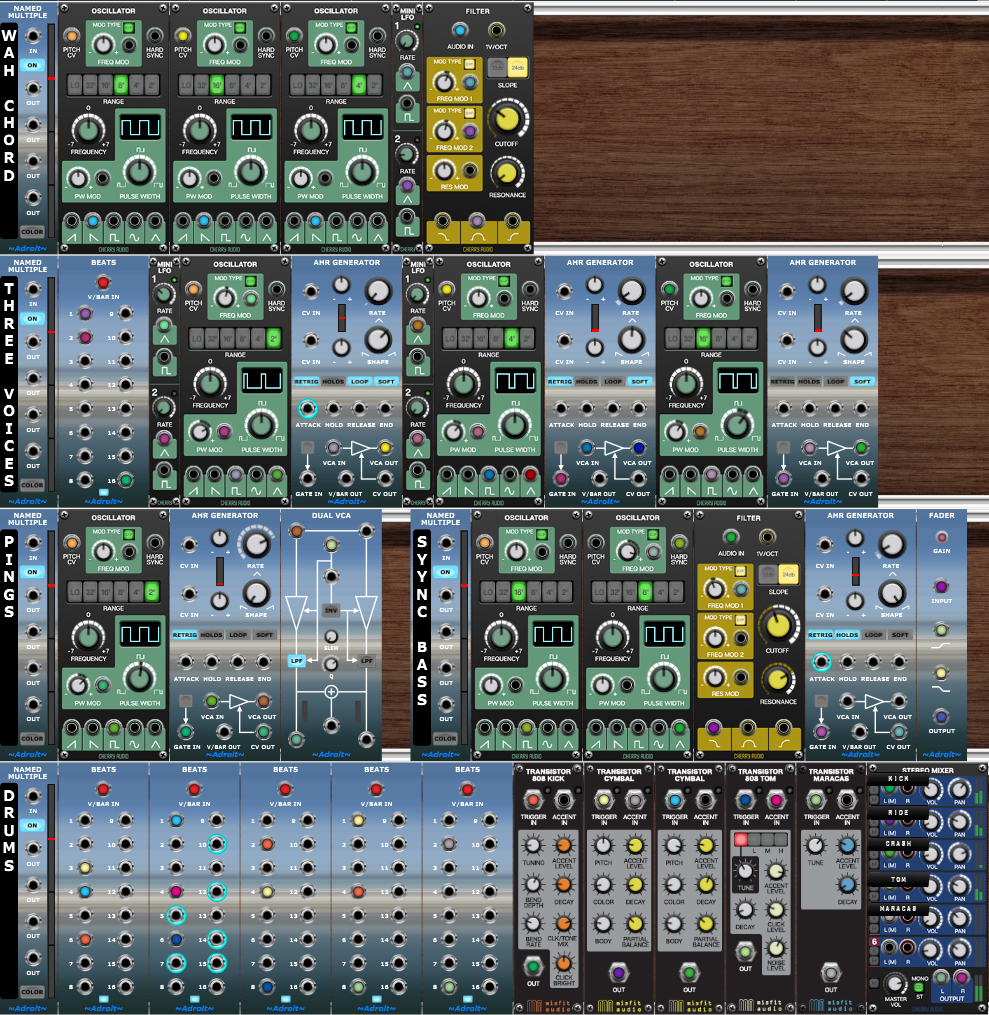
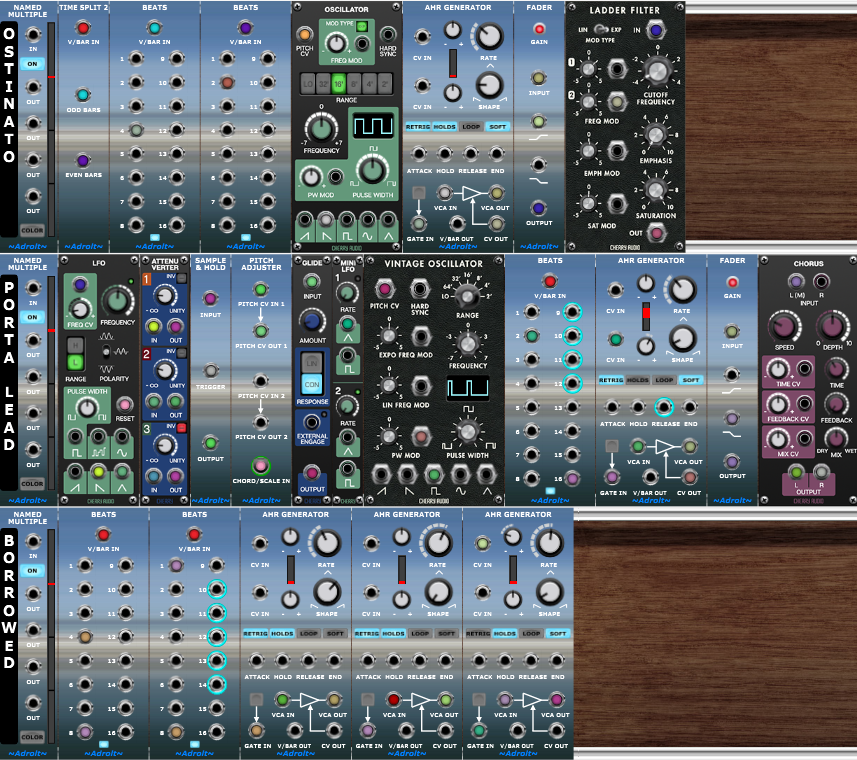
Note that this patch is sufficiently demanding that it won’t run on some older machines. But it works fine on my laptop with a total CPU load of about 20%. If you are having problems then some tips about maximising performance are discussed here.
If you have an old machine that can’t cope then you can selectively remove one or more of the lower seven cabinets to lighten the CPU load without interfering with the basic sequencing and mixing. So hopefully the following descriptions will still be of some value even if you can’t get the entire patch running.
The idea of this patch is to demonstrate how LSSP might be used to create a song that’s more of a soundscape than some of the other demos on this website. Rather than the typical verse-chorus-bridge structure it’s a simple rhapsody.
It’s named after a storm that hit the UK with winds of up to 98 mph. So it has a relentless feel but is not perhaps what one might expect of a composition about a storm. I had just finished a piece called 1918 that was very sombre so I wanted something that had a lighter feel. It took about 15 hours spread out over a couple of weeks to put together.
Chord Progression
Although this composition is 72 bars and three and a half minutes in length it uses only three chords, each chord consists of just three notes and the chord progression loops over and over. Yet it doesn’t feel like it is so primitive because the chord progression is unusual (and the orchestration constantly evolves).
A typical three chord song uses I, IV and V but these chords are so familiar and coherent that a piece built on these chords wouldn’t be capable of evoking a fierce storm.
Here’s the 8 bar chord progression that is repeated 9 times…
| I sus4 | \ | i | \ |
| bII sus2 | \ | i | \ |
Or using chord names…
| D sus4 | \ | Dm | \ |
| Eb sus2 | \ | Dm | \ |
You can see what these chords look like on a piano keyboard as a Note Watcher module is attached to the output of the Progression module…



The interesting thing about suspended or “sus” chords is that they don’t have a third interval yet it is whether a chord includes a major or minor third that determines whether it has a major or minor feel. Therefore suspended chords sound quite distinctly neither major nor minor. So although the Dm chord makes it sound like the key is D minor the suspended chords add a mysterious and appropriate ambiguity to the tonality.
Another interesting thing about the chord progression is the inclusion of an Eb in the Eb sus2 chord as Eb isn’t in any D minor scale (natural, harmonic or melodic). So now and then a non-diatonic note pops up to add a bit of spice.

Finally the tonal movement from Dm to Eb sus2 is a mere semitone and is kind of dramatically undramatic because the journey is so short and relatively dissonant.
These elements combined make the chord progression capable of sustaining interest and tension despite it being just three three note chords being played in a static pattern over and over throughout the entire piece.

The chord section of the patch is contained in one whole cabinet. The root notes are derived from a Chromatic Scale module whose KEY IN socket is connected to the Song Control module’s KEY out socket so that the key can be selected from its menu.
The TONIC and MINOR 2ND outputs from the scale module provide the root notes for the three Chord modules that produce the S-Poly chord signals. Note that the MINOR 2ND output is labelled D# but this is the same pitch as Eb.
D# and Eb are enharmonic equivalents. I’ve called the Eb sus2 chord an Eb chord rather than a D# one because it’s a convention to name chords with different letters when they have different roots. But you could think of it as D# sus2 if that makes more sense to you.
The outputs from the Chord modules feed into a Progression module. The chord progression is only 8 bars in length but by default the Progression module handles progressions that are 16 bars long. Setting the module to use 2 CHORDS/BAR instead of 1 means that the sequence cycles in 8 bars, this makes it easier to patch the chord progression as it doesn’t need to be repeated.
The CHORD OUT socket of the Progression module is fed to a Note Watcher so we can see which notes are active, to an S-Poly to Mono module that splits up the current chord into its constituent notes and to a Pitch Adjuster in the Porta Lead part of the patch.
The Mix
This patch uses quite a few voices and four separate six channel Stereo Mixers so it’s not entirely obvious at first glance how the mix is structured but as you can see from the diagram below it’s not too complicated.
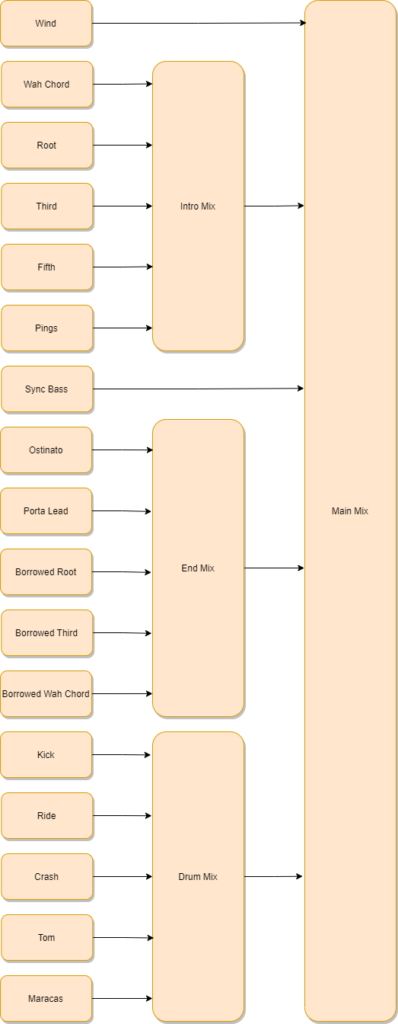
“Dynamo” style labels are attached to each mixer channel to help you navigate.
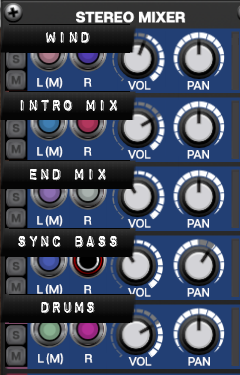
A mix with this many elements would benefit from EQ and compression applied here and there but I had limited time available and the end result is good enough for a demonstration piece.
Sequencing Overview
The sequencing in this demo is relatively simple as the song is essentially just a string of 8 bar long sections that each match the repeating chord progression.
Detail is provided by fading between different voices using Fader modules combined with some fairly straightforward V/Bar sequencing of Beats modules. Nine chained Song Part modules provide both the fading and V/Bar signals. A tenth Song Part module at the end adds a couple of bars for the reverb to fade away and time for your mind to reset if the song is set to repeat.
As the rhythms involved are meant to be rather pounding and relentless then there was no point in using the more sophisticated facilities provided by the Rhythm Sequencer and Drum Sequencer modules so all the rhythms are driven by Beats sequencers, The Beats module might seem like a rather unexciting module but it’s perfect for this kind of application.
The descriptions below follow a rough chronological order of how various elements of the orchestration are introduced and then removed.
Wind
You can’t have an electronic music composition about a storm without a bit of modulated colored noise. It’s perhaps one of the first things anyone does when they get their hands on a white noise generator and a bandpass filter and while it’s a bit cheesy, it’s hard not to like.
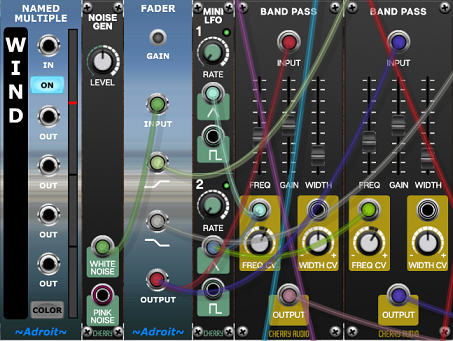
This wind implementation uses a Fader module to fade the white noise output of the Noise Generator in over two bars of Song Part 1 then out over 14 bars of Song Part 2.
The mono white noise signal is then fed to two Bandpass Filter modules each controlled with a separate LFO running at a slightly different frequency. The outputs of the filters then go straight into the left and right inputs of one of the channels in the Main Mixer. The different cycles of the LFOs give a stereo feel. It’s very wide but it soon gets lost in the mix so this isn’t really a problem.
Wah Chord
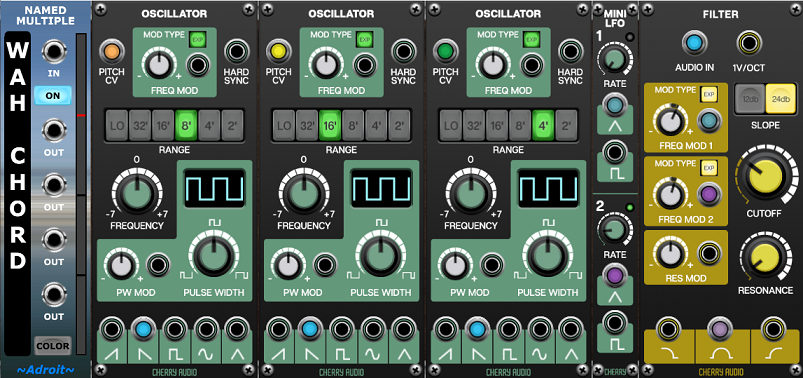
The Wah Chord element is a throbbing drone that occurs during the introduction and reappears in modified form at the end of the song.
Three Oscillators are used. Their pitches are the three pitches of the current chord but with different octaves to spread the sound out in the frequency spectrum. Sawtooth waves are used too in order to produce a rich spectrum.
The outputs of the oscillators are summed and passed into a Filter with a bandpass response. Two LFO’s running at different rates are used to control the filter’s cutoff frequency and resonance. The cutoff frequency modulation produces the wah-wah sound while the modulation of resonance adds some character that changes at a much slower rate.
The bandpass output of the filter is fed into an input of the Intro Mixer. The output of which is controlled by automated fading so although the Wah Chord element produces an audio signal throughout the song it’s only audible when required.
Three Voices
The next element labelled “THREE VOICES” consists of three simple voices. As with the Wah Chord element we have three oscillators each playing different notes in the current chord. However, the octave settings are different to those assigned in Wah Chord, square/pulse waves are used instead of sawtooths and rather than all the oscillators droning constantly each oscillator output is treated separately.

The oscillator on the left plays the root note. The oscillator in the middle plays either the second, third or fourth note (depending on the chord type) but its channel in the Intro Mixer is just labelled “THIRD” for simplicity’s sake. The oscillator on the right plays the fifth note of the chord.
A potential source of confusion when talking about things like the third or fifth note is that these terms refer not to the numerical ordering of notes but to their pitch intervals. So a “fifth note” has a pitch interval of a fifth to the root note rather than being the fifth note in a set of notes.
Four free running LFOs (contained in the two Mini LFO modules) provide modulation. One is used to add subtle vibrato to the root note, the other three slower ones add independent pulse width modulation for each of the oscillators. As the LFOs all have different rates the overall effect is subtly complex.
Each voice has it’s own AHR Generator module and these serve as both envelope generators and VCAs for each voice.
The root voice’s AHR Generator is set to loop asynchronously so the root fades slowly in and out in its own time frame.
The third (second/fourth) voice’s AHR Generator is triggered by the 2 output of the Beats sequencer on the left of the sub-patch. This makes it trigger twice each bar.
Note that the SHAPE control is set for a triangular shape but because the RATE control is pretty low and the RETRIG button is engaged the envelope resets early – causing a rising sawtooth envelope that sound like something played backwards. You could get the same result without the retriggering if you used a faster rate and a different shape but often one arrives at the result one wants without having to get too analytical about it.
The fifth voice’s AHR Generator is triggered by the 1 output of the Beats sequencer so plays once per bar.
The three resulting envelope signals look something like this snapshot…

Note that the SOFT button is engaged on all three AHR Generators, this causes the contours to be smooth rather than angular.
Finally, each voice is fed to its own channel on the Intro Mixer and given a different pan position.
Note that no filtering is used on these voices as they are meant to be strident tones signifying fear of the imminent danger of high winds.
Pings
The Pings element is a simple high-pitched staccato voice. It fades in gradually yet because it plays 16 times per bar it suggests urgency. It’s an alarm bell of sorts.
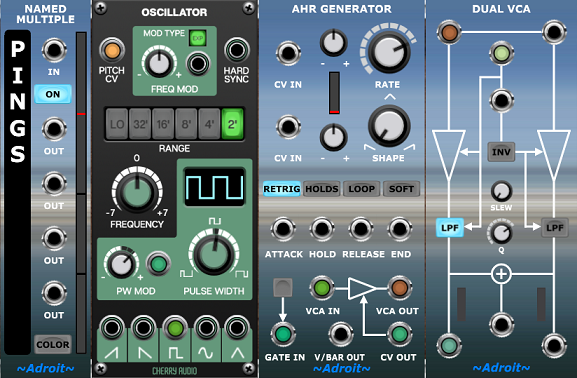
The oscillator plays the root pitch but in a high octave. A pulse waveform is used with rapid pulse width modulation provided by patching the CV OUT of the AHR Generator to the PW MOD socket. The AHR Generator’s built-in VCA controls the envelope of the sound and the SHAPE is set to its most percussive setting and the RATE is set pretty fast.
The fade in is controlled by one channel of a Dual VCA module with the LPF button engaged. So as Song Part 3 progresses the Pings voice not only increases in volume but its tone changes too – becoming ever brighter. The Q knob is turned up enough to make this slow filter sweep even more obvious.
The output from the VCA is fed to a channel of the Intro Mixer.
As Song Part 4 plays the pings are faded out along with everything else in the intro mix.
Sync Bass
The Sync Bass element uses the hard synchronization of one oscillator by another to create a fairly complex sound with the minimum of effort.
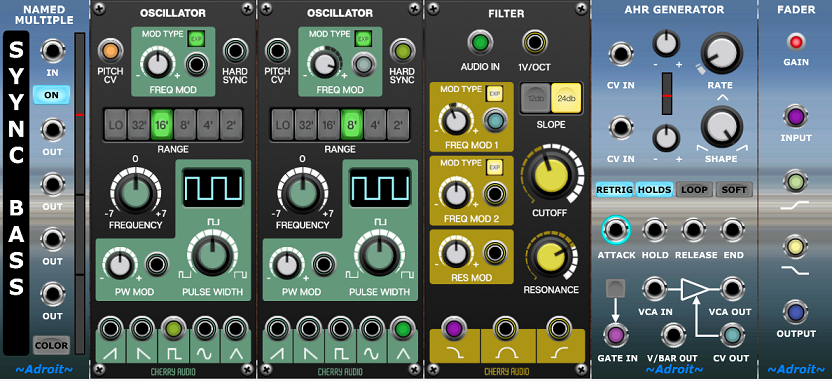
The oscillator on the left (set nominally an octave below the one on the right) plays at the root pitch of the current chord. The oscillator on the right has its pitch swept by the CV OUT signal from the AHR Generator. The FREQ MOD facility is used rather than the PITCH CV input just so that the knob can be used to control the range of this sweep.
The AHR Generator is triggered at the beginning of each bar and outputs a slow rising sawtooth. This makes the right-hand oscillator sweep upwards in pitch but instead of a smooth rising pitch we hear something that remains in tune with the root note because the right-hand oscillator’s waveform is reset every cycle by the left-hand oscillator. The result of this sync is like an interesting cross between a filter sweep and a very fast arpeggio.
This element is a drone voice with no envelope. A Fader module is used to fade it in during Song Part 3 and out during Song Part 6. The output of the Fader module is patched to a channel in the Main Mixer.
Drums
Drums are introduced in Song Part 5 and signify the peak of the storm. As mentioned earlier only Beats modules are used to sequence rhythms in this patch because fairly repetitive patterns work well to convey a relentless feel.
Five different patterns are generated by variations in the patching of trigger signals from five different Beats modules to an array of drum modules. Each Beats module is brought into play by being fed a V/Bar signal from a Song Part module.
Although there’s a lot of repetition there is still a degree of rhythmical sophistication as various events occur at rates of 1, 2, 3, 4, 6 and 8 times per bar and drum elements swap places over time. In the image below you can see how the kick drum changes pace several times.

The drum modules’ outputs are fed to a mixer that allows the tweaking of levels and for the drums to be spread out in a stereo image,
Ostinato
Ostinato means obstinate or stubborn in Italian. This element replaces the Sync Bass in a cross-fade during Song Part 6. It serves a similar role to the Sync Bass element but feels more static in pitch and gives one the impression that the storm might never end.
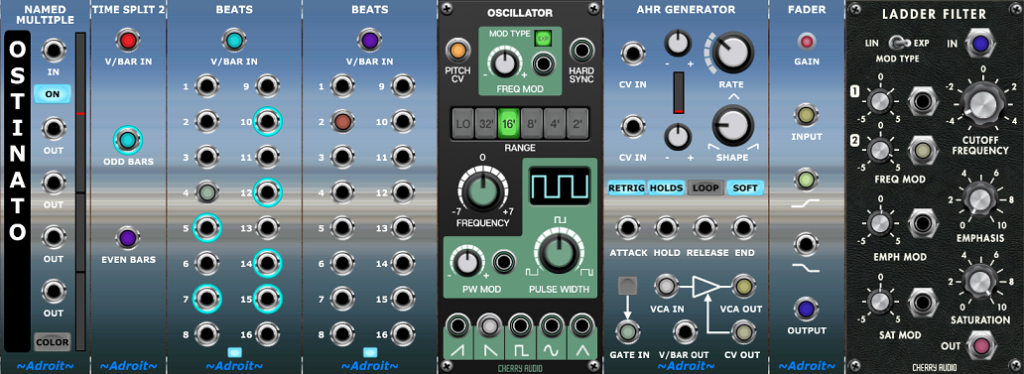
The oscillator plays a low octave root note and its sawtooth output is fed through the built-in VCA of an AHR Generator.
The AHR Generator is triggered by a two bar pattern from a pair of Beats modules that are sequenced by a Time Split 2 module. So in odd numbered bars it triggers four times and in even numbered bars it triggers twice.
This 1 2 3 4, 1 – 2 – pattern actually sounds like five beats, a rest, another beat and a final rest or 1 2 3 4 5 – 6 – .
The CV Watcher image below show the rhythms in play in Song Part 6. The red and yellow traces are the Ostinato rhythm the others are various drum parts.
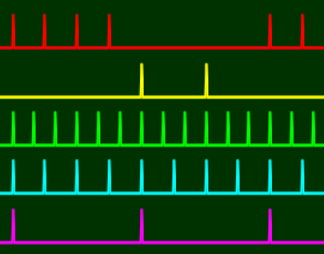
The signal from the VCA is then passed through a Ladder Filter. The cutoff frequency of this lowpass filter is heavily modulated by the CV OUT of the AHR Generator and the slightly sluggish attack produces the pronounced brass like timbre.
The output from the filter is fed to a channel in the End Mixer. The outputs of the End Mixer in turn feed a stereo channel in the Main Mixer.
Porta Lead
The Porta Lead voice is supposed to represent hope that the storm will end. It is deliberately a slightly unstable voice as hope involves uncertainty, although in the very last 8 bar section of the song the voice drops an octave, this makes the voice sound more serious and is intended to mean that the sense of doubt has been reduced considerably.
Porta is short for Portamento. – the gliding of pitch between notes.
The melody line is produced by a simple generative technique that uses an LFO, sample and hold and pitch quantization.

An Attenuverter module is used to control the levels of sawtooth and and triangular waveforms from the LFO. Mixing the waveforms together produces a more interesting contour than just one or the other and the attenuverter provides a little artistic control.
In the image below the red and yellow traces show the LFO outputs and the green trace shows the mix that is sent to the input of the Sample & Hold module.
The CV Watcher traces have had their vertical magnification adjusted to make this image easier to understand, so the signals are not to scale.

The signal shown in green is fed to the input of the Sample & Hold module which samples the voltage every time it receives a trigger input. This trigger is provided by the Beats module’s output 16 so the voltage changes every 16th note. But this voltage is not musically useful as the notes are not “in tune”. It’s therefore passed through a Pitch Adjuster module to adjust the voltage to fit the nearest note in the current chord. This musically adjusted signal is shown in the cyan trace above.
One final bit of processing is applied before the signal is used to control the pitch of the Vintage Oscillator. It is passed through a Glide module that slows down the change in pitch to produce the portamento effect. The final control signal is shown in the magenta trace above. It’s subtle but if you look closely you can see that the pitch jumps are no longer perfectly vertical. The slope isn’t dramatic visually but the difference in sound is very noticeable.
One potential problem with this generative technique is that normally the LFO is free running and this would cause the melody line to be non-reproduceable as the LFO could be at any point in its cycle when you hit the PLAY button on Song Control. But this problem is easily solved by resetting the LFO’s cycle with the rising edge of the IS ACTIVE output from Song Part module 7.
The LFO reset pulse is taken from the Song Part 7 module rather than the START OUT socket of Song Control just to make the sync work more reliably during song development when SOLO buttons and the forwards and backwards buttons are being used to skip around and tweaks are being made
The red trace in the image below shows the LFO’s output and the yellow trace shows the signal from the IS ACTIVE output of the Song Part module. Notice how the LFO jumps back up to the beginning of its cycle on the rising edge of the IS ACTIVE signal.

This is the same kind of sync mechanism as used at a much higher frequency in the Sync Bass sub-patch.
The octave drop for the final section of the song is implemented by passing the IS ACTIVE signal from Song Part 9 through the spare attenuverter which is set to invert the polarity of the signal and attenuate it from 5 volts to 1 volt
Attenuator Knob 3 is set to 20% (20% being 1/5) so when Song Part 9 becomes active a minus one volt offset is applied to the oscillator’s 1V/Octave input causing the pitch to drop by one octave.
The audio signal from the oscillator is a pulse wave with pulse width modulation applied using the envelope CV signal from the AHR Generator to make the spectrum vary over the lifetime of each note.
The AHR Generator is triggered every 16th note by the Beats module. To add a little variation the shape of the envelope is gently modulated by a slow LFO.
The AHR Generator’s built-in VCA applies an amplitude envelope and the result is fed through a Fader module in order is to fade out the Porta Lead sound over the duration of the final 8 bar section.
The final signal passes through a Chorus module to add a nice swirling effect and the result is sent to a channel of the End Mixer.
Borrowed
The so called Borrowed section is a collection of three voices that reuse existing resources. A patch of this size is taxing on old machines so it makes sense to do a bit of recycling in order to reduce CPU load. This can also add some coherence and a sense of returning full circle to a song.
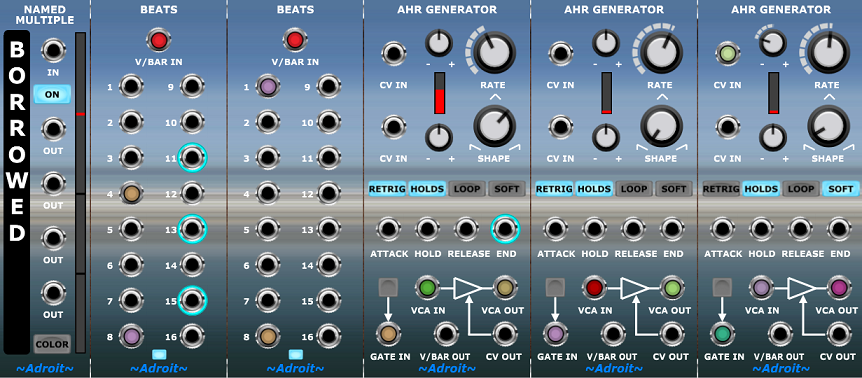
This section is driven by a couple of Beats sequencers – one running during Song Part 8, the other during Song Part 9. Outputs from these trigger the three AHR Generators which use their built-in VCAs to add envelopes to signals retrieved from sources that have already been used.
The left-hand AHR Generator handles the triangle wave output of the root oscillator in the Three Voices element.
The middle AHR Generator handles the triangle wave output of the third (second/fourth) oscillator in the Three Voices element.
The right-hand AHR Generator recycles the Wah Chord drone output. This AHR Generator has an important modulation of its rate during the final 8 bars. As the tempo drops (as discussed shortly) the rate drops too, so that the duration of the Wah Chord increases from a quick blip to a sustained chord at the very end of the song.
Ritardando
The song concludes with a ritardando section where the tempo gradually drops from the 86 BPM used throughout the piece to a very sedate 68.4 BPM. This -33% drop in tempo is quite dramatic and signifies the end of the storm and a relax in tension.
The ritardando is controlled by the fade in output of Song Part 9. The key connection is to one of the CV input sockets of the Tempo module. The corresponding attenuverter for the CV input is set to -33%.
Another connection is from the fade in socket to the FREQ IN socket of the pitch sequence controlling LFO used in the Porta Lead element. This makes the Porta Lead element melody slow down in tandem.
Finally the fade in signal also adjusts the rate of the right-hand AHR Generator in the Borrowed section to make the Wah Chord voice sustain for longer and longer as the end nears.